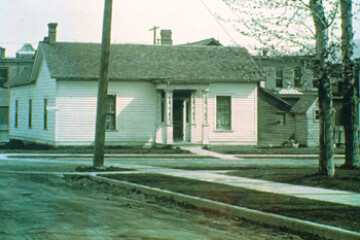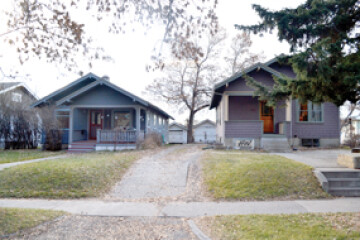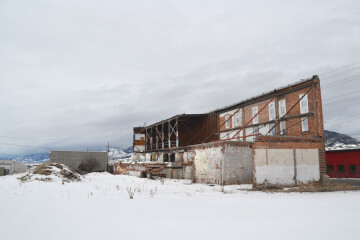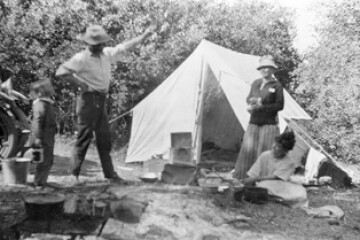Historic District Spotlight: Lindley Place
It’s easy to miss the Lindley Place Historic District. Separated from Bogert Park by Bozeman Creek, the neighborhood flanks Lindley Place as well as the north side of East Olive Street. The middle class neighborhood developed in two phases, between 1880 and 1900 and then again between 1911 and 1922.
Prior to becoming a residential neighborhood, water from Bozeman Creek powered lumber mills in the area. Lumber finishing was a profitable business in the 1880’s as Bozeman’s economy boomed after the arrival of the Northern Pacific Railway in 1883. The Koch and Koch Steam Planing Mill was located on South Church Avenue across the street from what is now Bogert Pool. The Aylesworth and Edsall Mill sat further to the east, along Mill Creek.
About 1880, Bozeman pioneers Joseph Lindley and John Guy located a lumber mill at the intersection of South Rouse Avenue and East Olive. The oldest houses in the district, at 207 and 211 Lindley Place, were constructed for mill workers in the “shotgun” style; one room wide and multiple rooms in length.
At the same time, the Lindley and Guy Addition was platted and lots sold for residential development. Constructed in 1886, the residences at 218, 301 and 309 Lindley Place are defined as “vernacular” in architectural style. This term reflects the everyday design and construction techniques adopted by builders in a community, usually without the influence of a trained architect.
Many residences in the district can be connected to a specific architectural style. Built in 1888, the home at 317 Lindley Place includes an asymmetrical facade, a steeply pitched roof, patterned shingles and a full width wrap-around porch, all of which are hallmarks of the Queen Anne style. The property was home to George Highsmith, a blacksmith who arrived from Illinois in 1882 and initially worked for Frank Harper. Highsmith and partners bought Harper’s blacksmith operation in 1885.
The Robertson House, at 323 Lindley Place, is a more modest vernacular residence with Queen Anne styling. The house was likely built by carpenter John Robertson, a Canadian who arrived to Bozeman in 1890 and served as Bozeman’s City Marshal and Chief of Police for about two decades.
Ten residences lined Lindley Place by 1891. Joseph Lindley added an eleventh, a two story brick home at the corner of Lindley and East Olive, in 1892. Born in 1840 in Indiana, Lindley was discharged from the 1st Kansas Volunteers after being wounded in 1861. Lindley worked as a freighter, hauling goods between Salt Lake City, Southern California and Virginia City, Montana. He arrived in Bozeman in 1864 and developed farming and cattle raising businesses, primarily in the Yellowstone Valley.
He sold those interests in 1882 and started loaning money and developing real estate. By 1890, Lindley’s business interests included real estate, insurance, conveyancing, a notary public, US pension agent and concrete block manufacturer. Lindley’s concrete block factory, located across Bozeman Creek at 412 East Olive Street, is now a storage warehouse. The concrete block Lindley House, at 406 East Olive, was rehabilitated and painted yellow in 2009.
Lindley also developed a notorious feud with Bozeman entrepreneur Nelson Story which centered on the use of water rights from Bozeman Creek. At one point at the turn of the 20th century, the rivalry came to physical blows, with Lindley penning nasty letters to Story and Story charging Lindley of insanity. In one memorable incident, Story’s men cut down trees to dam Bozeman Creek above Lindley’s water intake. Lindley planted an explosive device, possibly made by Highsmith’s blacksmith shop, in the log jam in order to regain access to water to power his mill at the east end of Main Street, where Lindley Park is now located.
Residential development along Lindley Place slowed after the financial panic of 1892. Six homes were constructed in the area between 1891 and 1904, all in the vernacular style. A second wave of home building began in 1911, as Bozeman’s economy thrived alongside the Homestead Boom, growth of Montana State College, a growing seed pea canning business and other agricultural-related industries.
The Craftsman Bungalow style replaced Queen Anne in the decade between Lindley Place’s two phases of development. With roots in India, California and Frank Lloyd Wright’s Prairie Style, companies like Sears and Roebuck and Montgomery Ward popularized the Bungalow style by selling houses in kits delivered to the building site by train. The style is characterized by low-pitched, gabled or hipped roofs with wide eve overhangs and front porches.
All 12 of the residences built in the Lindley Place District between 1911 and 1922 are Bungalow style. Carpenter J.H. Mimmack built two Bungalows at 326 and 330 Lindley in 1913, and then three in 1919, including his personal residence at 212 Lindley Place. Mimmack and his wife participated in advertisements for the Montana Power Company which touted the inclusion of an electric stove in each of his new Bungalows.
Mimmack’s neighbors included Henry T. Voyer, an electrician for the Electric Railway and the aptly-named Martin Plumb, a plumber in the firm Plumb and Lundwall. John Robertson, the Canadian Marshal and Chief of Police, liked the neighborhood so much he built himself a simple Bungalow at 303 East Olive in 1922, thirty years after constructing his earlier home at 323 Lindley Place.
An older home at 217 Lindley Place was demolished in 1919 to make way for a new Bungalow. The older structure shows up on the 1889 Sanborn Fire Insurance Map, which also recorded two glass-roofed greenhouses south of the residence. The buildings may have been associated with the strawberry growing business that neighborhood developer John Guy operated in partnership with TB Gray during the 1880’s.
Born in Virginia in 1823, John Guy moved with his family to Missouri and Texas before heading to California in the 1849 gold rush. In 1855 Guy arrived in Denver and operated a farm and hotel near Denver. Guy followed the Montana gold rush to Alder Gulch and developed another hotel in Highland, about five miles “up the gulch” from Virginia City.
In 1864 Guy and his wife Amanda settled in the Gallatin Valley. After Guy’s election to county sheriff in 1866, the couple moved into Bozeman and developed the Guy House, a two-story hotel built in 1868 on the northwest corner of Main and Black (where the Story Block now sits). The Guy House became the center of the town’s social life and temporary shelter as new community members awaited construction of their new homes. Guy served four terms as Gallatin County sheriff before moving to Custer County in 1877. East Koch Street, the southern terminus of Lindley Place, was originally named in Guy’s honor.
The Lindley Place Historic District added to the National Register of Historic Places in 1986. In 2011, “This Old House” magazine named the Lindley Place District one of the Best Historic Districts to live in, for its proximity to Bozeman’s commercial area and distinctively residential setting.






